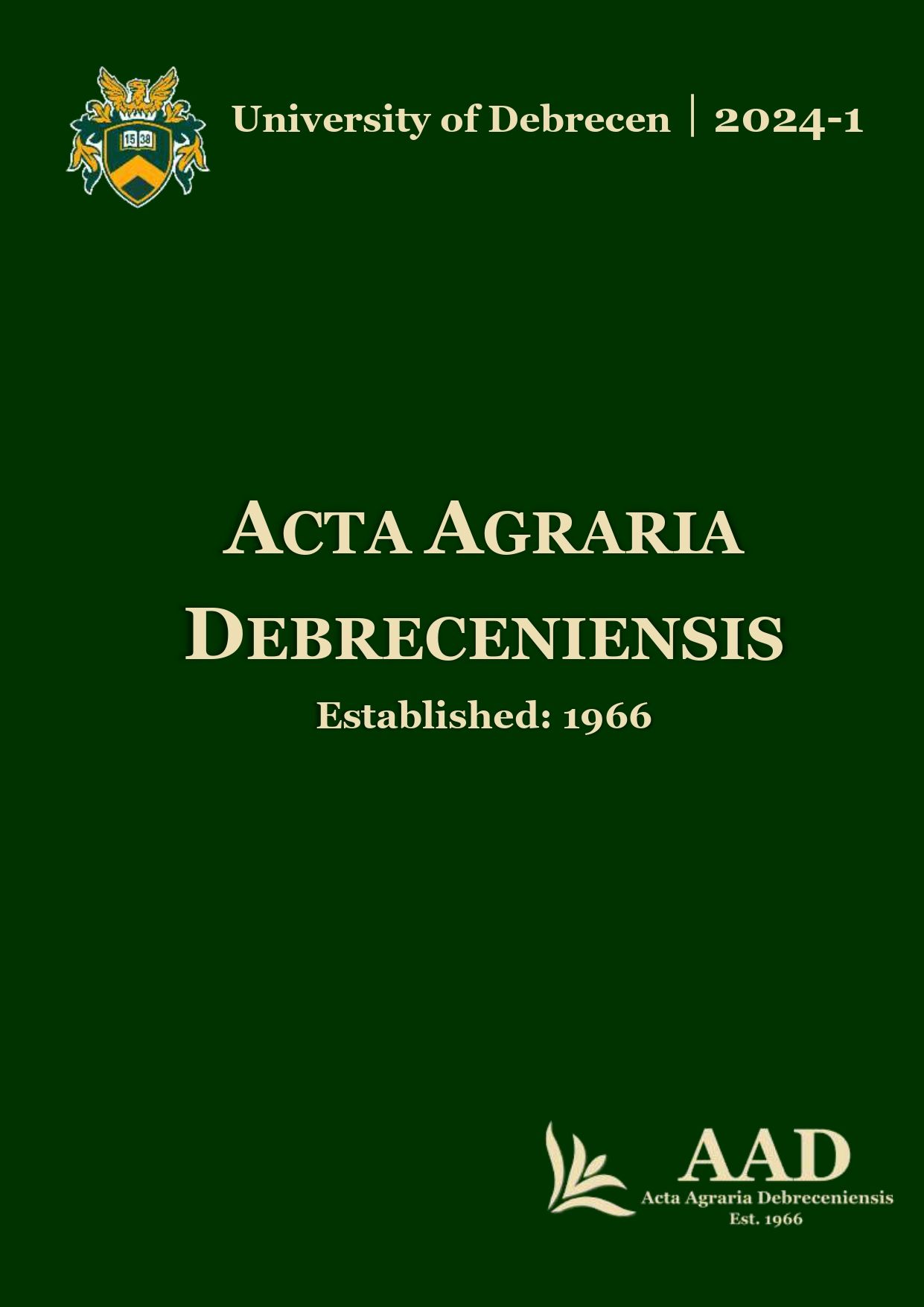Impact of precision irrigation on the unit income of maize production
Authors
View
Keywords
License
Copyright (c) 2024 by the Author(s)

This work is licensed under a Creative Commons Attribution 4.0 International License.
How To Cite
Accepted 2024-04-10
Published 2024-06-03
Abstract
The study of the economic/economic impact of precision farming should be a priority area in digital agriculture, as the results, profitability, and efficiency indicators can have a significant decision-support effect on the development of both the agronomic and the technical regions of individual farms both in the longer and shorter term. Individual firms, companies, farmers, and family farms quantify the effectiveness of their farming processes. The modern age offers the possibility of digitally recording all the elements of farming technology, making it possible to analyse the cost-effectiveness of a farm more effectively and, in some cases, to carry out more detailed analyses. Nevertheless, the number of farms demonstrating their profitability with such precise economic calculations is still minimal.
Our analyses were conducted on a 56,02 ha field of Balogh Farm-Tépe Ltd. The agricultural operations carried out were fully documented so that the inputs (seeds, fertilisers, pesticides, crop enhancers) were recorded in coordinates and kind, as well as the specific yields, grain moisture data, irrigation norms, and irrigation rotations. At the same time, the company's owner provided the data's monetary value. The main econometric indicators (yield, production value, cost of production, income, cost price) related to the evaluation of the enterprise management were evaluated along with the spatial data in the irrigated and non-irrigated tables. Our calculations show that a given year's climatic and market characteristics fundamentally determine the cost and income relations of a plot of land (and thus of an entire farm). In addition to additional inputs, introducing some elements of precision farming and intensification and increasing yields improves yield security and allows for excellent yield stability.
References
- Birkás, M. (2001): A Talajhasználat. A talajhasználati módok értékelése. In: Talajművelés a Fenntartható Gazdálkodásban. Birkás, M. (szerk). Akaprint Nyomdaipari Kft. 99–120.
- Bondesan, L.; Ortiz, B.V.; Morlin, F.; Morata, G.; Duzy, L.; van Santen, E.; Lena, B.P.; Vellidis, G. (2022): A comparison of precision and conventional irrigation in corn production in Southeast Alabama. Precision Agriculture. 24: 40–67. https://doi.org/10.1007/s11119-022-09930-2
- Bora, G.C.; Nowatzki, J.F.; Roberts, D.C. (2012): Energy savings by adopting precision agriculture in rural USA. Energy, Sustainability and Society. 2 (22): 1–5. https://doi.org/10.1186/2192-0567-2-22
- Buzás, Gy.; Nemessályi, Zs.; Székely, Cs. (2000): Mezőgazdasági üzemtan I. Mezőgazdasági Szaktudás Kiadó, Budapest, 461 p.
- Ciscar, J-C.; Iglesias, A.; Luc, F.; Szabó, L.; van Regemorter, D.; Amelung, B.; Nicholls, R.; Paul, W.; Ole, B.C.; Rutger, D.; Garrote, L.; Goodess, C.M.; Alistair, H.; Moreno, A.; Richards, J.; Soria, A. (2011): Physical and economic consequences of climate change in Europe. Proceedings of the National Academy of Sciences of the United States of America. 108. 2678–83. https://doi.org/10.1073/pnas.101161210
- Darab, K. (1958): A tiszántúli öntözött réti talajok másodlagos szikesedése. Agrokémia és Talajtan. 7 (1): 53–64.
- Evans, R G.; LaRue, J.; Stone, K.C.; King, B.A. (2013): Adoption of site-specific variable rate sprinkler irrigation systems. Irrigation Science. 31 (4): 871–887. doi: 10.1007/s00271-012-0365-x
- Hadászi, L. (2022): Menedzsment zónák alapján tervezett kukorica tőszámvizsgálat öntözött és öntözetlen körülmények között. Diplomadolgozat. Debreceni Egyetem, Mezőgazdaság-, Élelmiszertudományi- és Környezetgazdálkodási Kar. Földhasznosítási, Műszaki és Precíziós Technológiai Intézet. 42 p.
- IPCC (2023): Climate Change 2023 Synthesis Report. IPCC, Geneva, Svájc, 115 p.
- Kemény, G.; Lámfalusi, I.; Molnár, A. (2018): Az öntözhetőség természeti-gazdasági korlátainak hatása az öntözhető területekre. Agrárgazdasági Kutató Intézet. Budapest. 178 p.
- LaRue, J.; Evans, R. (2012): Considerations for variable rate irrigation. In: Proceedings of the 24th Annual Central Plains Irrigation Conference. Colby, Kansas. 111–116.
- Ligetvári, F. (2008): Öntözés. Szent István Egyetem. Mezőgazdaság- és Környezettudományi Kar. 117 p.
- Molnár, A.; Kiss, A.; Illés, I.; Lámfalusi, I. (2018): A precíziós és konvencionális szántóföldi növénytermesztés összehasonlító vizsgálata. Gazdálkodás. 62 (123): 123–134.
- Mustek, J.T.; Dusek, D.A. (1980): Irrigted corn yield response to water. Transactions of the ASAE. 23 (1): 0092–0098. doi: 10.13031/2013.34531
- O’Shaughnessy, S.A.; Evett, S.R.; Colaizzi, P.D.; Andrade, M.A.; Marek, T.H.; Heeren, D.M.; Lamm, F.R.; LaRue, J.L. (2019): Identifying advantages and disadvantages of variable rate irrigation: an updated review. Applied Engineering in Agriculture. 35 (6): 837–852. doi: 10.13031/aea.13128.
- Payero, J.O.; Melvin, S.R.; Irmak, S.; Tarkalson, D. (2006): Yield response of corn to deficit irrigation in a semiarid climate. Agricultural Water Management. 84 (1–2): 101–112. https://doi.org/10.1016/j.agwat.2006.01.009
- Rakonczai, J. (2021): Elfogyasztott jövőnk? Globális környezeti és geopolitikai kihívásaink. Budapesti Corvinus Egyetem. 303 p.
- Szabó, E.; Fórián, T.; Riczu, P.; Mészáros, G., Hadászi, L.; Dobos, E. (2022): A domborzati paraméterek és műholdfelvételek segítségével körül határolt zónák és az őszi búza hozam összefüggése változatos talajtani adottságokkal rendelkező területen. In: Az agrokémia, a talajtan és a kapcsolódó tudományok időszerű kérdései. Szerk.: Balláné Kovács A., Kocsiné Demjén Á. Debreceni Egyetem. Mezőgazdaság-, Élelmiszertudományi és Környezetgazdálkodási Kar. Debrecen, ISBN: 9789634904717. 315–326.
- Szabó, G. (2019): Maximalizálja a JDLinkTM-ben rejlő lehetőségeket! KITE Műszaki Magazin. 2019 (2): 8–11.
- Szabó, G. (2020): John Deere Operations Center – mostantól még egyszerűbb megtervezni a munkát - az elejétől a végéig. KITE Műszaki Magazin. 2020 (1): 8–9.
- Szabó, J.; Milics, G.; Tamás, J.; Pásztor, L. (2007): Térinformatika a precíziós mezőgazdaságban. In Németh T., Neményi M., Harnos Zs. (szerk.): A precíziós mezőgazdaság módszertana. JATE Press – MTA TAKI. 39–62.
- Várallyay, Gy. (2002): A mezőgazdasági vízgazdálkodás talajtani alapjai. MTA TAKI. Budapest. 171 p.
- Wolf, S.A.; Buttel, E.H. (1996): The political economy of precision farming. American Journal of Agricultural Economics, 78 (5): 1269–1274. https://doi.org/10.2307/1243505

 https://doi.org/10.34101/actaagrar/1/14107
https://doi.org/10.34101/actaagrar/1/14107